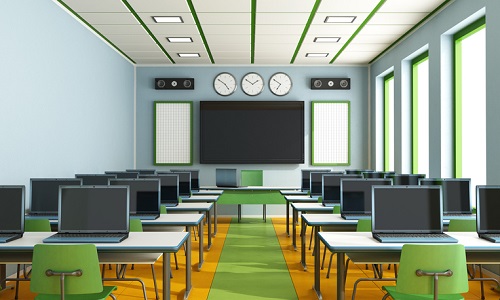
With the evolution of technology, classrooms have long since evolved from rows of students copying down notes from the whiteboard. Today’s students are now enjoying a full technological immersion.
Reports show that students’ levels of engagement within the learning environment are on a steep, upward trajectory, encouraging greater collaboration and more practical, real-world experiences within their curriculum.
According to Bignesh (Vicky) Dayal, Crestron’s Director of Education Solutions for Australia and New Zealand, the term “classroom of the future” does not accurately represent the changing state of learning.
Instead, Dayal likes to refer to “smarter learning spaces”, which better reflects the diverse education settings and ecosystems that are powered by an array of connected, smart technology.
“Referring to the current education environment as ‘the classroom of the future’ makes one think of a singular, traditional learning model where a teacher is lecturing at a smart board in front of a four-walled classroom of students who are on their laptops, which is already fast becoming out-dated,” Dayal told The Educator.
“Smarter learning spaces better encapsulate the new range of learning environments and methods being utilised in schools and universities across Australia.
Dayal said developments, such as the flipped classroom or students collaborating in integrated and immersive technology pods or hubs, are “new ways of learning enabled by a connected education environment”.
“Even now, lecture theatres can support direct interactions between one lecturer and hundreds of students via remote access learning, and universities have specifically set up practical learning spaces where students can apply theory,” he explained.
In such environments, says Dayal, students no longer have to be physically present in a classroom or lecture theatre to learn course materials.
“At the touch of a button, teachers can simply record a class which can be accessed by students later online or set up via a live broadcast for convenient viewing wherever they are,” he said.
“Campuses, whether they are schools or universities, are today so much more than classrooms and large lecture theatres.”
Dayal pointed out that student lounges, libraries, outdoor spaces and cafes have become “extended classrooms” for students to work and collaborate, boosted by technology, such as WiFi and technology tools.
“The classroom has essentially become portable on a phone, tablet or laptop. Students can be in a café or outdoor hubs while streaming a lecture, or using Google Slides to simultaneously contribute to a group work presentation,” Dayal said.
Dayal said today’s rapidly evolving professional landscape demands that students come into the workforce armed with the necessary knowledge and experience.
"As a result, we need high-performance technology both in and outside the four-walled environment," he said.
An example of a university leading the way in practical, collaborative teaching for its medical students is the Australian Catholic University. The university hosts a clinic where students are put in direct contact with real-life patients who visit for treatment and advice. Throughout the clinic are Crestron-integrated cameras and microphones that record students’ interactions with patients for self-review and assessments.
“These new modern learning environments are fitted with state-of-the art technologies that have expanded the breadth and depth of the traditional classroom. Through easy-to-use technology, students are interacting with course materials like never before,” Dayal said.
Related stories:
From best practice to next practice
Tech giant announces free coding workshops
How technology impacts teaching and learning


